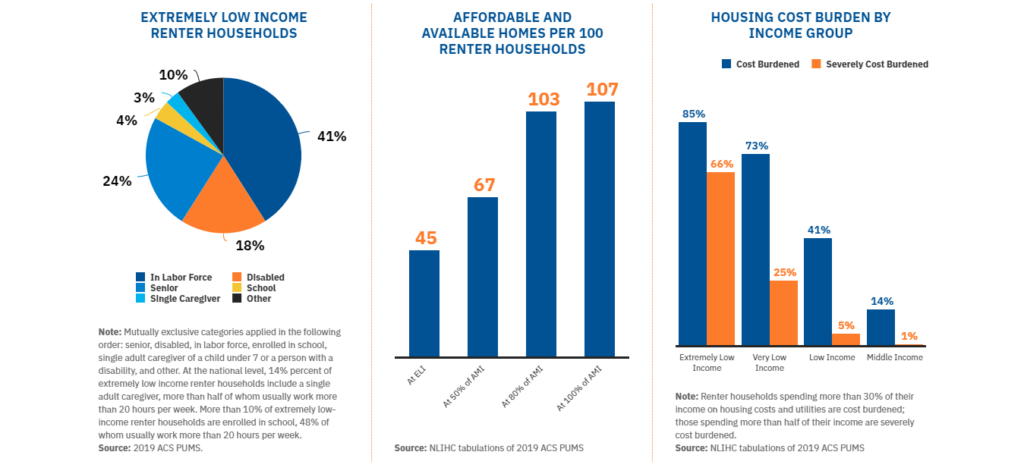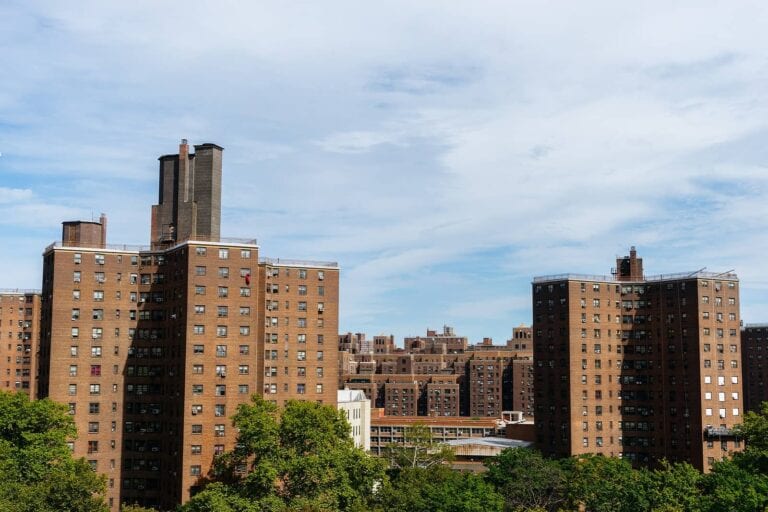In North Carolina, approximately 25% of renter households cannot afford 190,910 rental homes on the market.
Based on the National Low Income Housing Coalition’s (NLIHC) North Carolina housing profile report:
There is a shortage of rental homes affordable and available to extremely low income households (ELI), whose incomes are at or below the poverty guideline or 30% of their area median income (AMI).

Source: NLIHC Tabulations 2019
The lack of affordable housing is a huge problem not only in North Carolina real estate market, but in most states in the country. At the same time, it creates opportunities for developers and investors who have the ability to work with the government to mitigate the problem.
One of the goals of the Biden housing policy is to reinstate fair housing regulations. A provision of the Fair Housing Act of 1968 required communities to work to undo systemic racism and housing segregation. It was called the Affirmatively Furthering Fair Housing (AFFH) policy. The Department of Housing and Urban Development (HUD) suspended AFFH policies in 2020. Currently, it appears President Joe Biden has reversed the suspension and ordered the HUD to reinstate fair housing rules.
This shows that housing is a major theme in the Biden Administration’s efforts to tackle racial and income segregation.
For an investor interested in affordable housing, this article outlines some questions to ask if you want to make a profit while providing cheap houses for rent.
How profitable is the area or location?
Investors are seeing the potential in affordable housing as an appealing option in today’s markets, where demand outstrips supply.
What is affordable housing?
The HUD defines an affordable dwelling as one that a household can obtain for 30% or less of its income.
Why is affordable housing important for investors?
Affordable properties tend to have lower competition and full occupancy rates. Therefore, they almost always perform more reliably than Class A properties.
Related: Which Property Class Makes for the Best Real Estate Investment?
Greg Willett, RealPage’s chief economist, says:
There is growing investor interest in lower price-point products, whether the properties are part of an affordable housing program or just market-rate projects at the lower end of the price spectrum.
In 2018, CBRE reported that apartment properties that have formal restrictions on how much rents may rise due to participation in affordable housing programs represented 20-25% of 20-unit+ apartment properties.
Asides, the argument that AH tends to have a negative impact on property values and rental prices has been refuted. Trulia has conducted extensive research on this across the country. They examined the 20 least affordable markets in the country, analyzing more than 3,000 projects with low-income units over a 10-year period. Overall, there was no significant effect on the value of homes located near a low-income unit.
Trulia’s report states:
The bottom line for [people] who fear that property values will take a hit when a low-income housing project is located nearby is that their anxiety is largely unfounded – at least in cities where housing is expensive or in short supply.
But as with any real estate investing endeavor, you need to assess housing demand in the area and calculate the potential return on investment. What’s the expected cash flow? What’s the cap rate? What’s the average cash on cash return? You can determine these using Mashvisor’s rental property calculator. Calculate your potential rental profit – 30% of the median income in your area. Then add up operating expenses – taxes, insurance, maintenance costs, operating costs, and other fees. Mashvisor’s real estate investment tools will help you do this for dozens of properties in a matter of minutes.
Related: What Traditional Cap Rates by City Should Real Estate Investors Expect in 2021?
Willet says:
While you’re unlikely to hit a home run in return for individual AH investments, risk is fairly low because resident demand is strong and reliable.
What are the costs of investing in affordable housing?
Once you decide to invest in low income apartments, you should determine your operating costs. Apart from the cost of buying income property for sale, taxes, insurance, and maintenance, expenses might include major renovation fees and the cost of security updates.
Builders must consider acquisition cost (land) – when public or donated land isn’t available. Then they need to factor in construction costs and fees along with project management costs. If you’re a builder, this tool by Urban.org in partnership with the National Housing Conference, helps you calculate the cost of your affordable housing project.
If, alternatively, you’re thinking of investing in real estate properties that are already built, you can use Mashvisor’s investment property calculator to estimate all one-time start-up costs as well as recurring monthly expenses that you’ll need to cover.
What are the incentives?
Currently, there is far more demand for cheap apartments than available supply. On March 31, 2021, the Biden Administration released the American Jobs Plan Fact Sheet along with the Made in America Tax Plan. As part of the plan, the Administration promised to “build and modernize more than two million homes.” The President promised “a marked increase in the resources available through the Low Income Housing Tax Credit (LIHTC) and other housing incentives.”
On April 15, 2021, the Affordable Housing Credit Improvement Act of 2021, which calls for increased government assistance through the expansion of the Low-Income Housing Tax Credit, was introduced with co-sponsors from both chambers.
The LIHTC expansion is likely to work in conjunction with the Neighborhood Homes Investment Act tax credit, which proposes to allocate $20 billion over five years to rebuild 500,000 owner-occupied homes.
For builders and investors, incentives for acquiring or creating AH include:
- Tax credits – The Low Income Housing Tax program introduced in 1986 provides real estate developers and affordable housing investors with tax incentives for up to 10 years if the investment property would comply with set affordability criteria for a duration of 30 years.
- Opportunity Zones – The Opportunity Zones program, introduced from the Tax Cut and Jobs Act of 2017, offers tax incentives to large-scale real estate investors focused on developing or investing in Section 8 houses for rent nationwide.
Related: 21 Best Opportunity Zones to Invest in Real Estate in the US
- State-level tax breaks – There are places for example in the California housing market where builders might qualify for free land for subsidized housing. Also, at local and state levels, such investors and builders might qualify for tax breaks. In St. Paul, Minnesota, for example, investors who adhere to affordable housing requirements for up to 10 years on at least one fifth of their building’s units qualify for a 40% tax break.
- Subsidies – Landlords who provide Section 8 housing or income based apartments for rent receive the full rental market rate in the form of subsidies.
Related: Are Section 8 Rentals a Good Real Estate Investment Opportunity?
What are the guidelines for AH subsidies?
As an investor, you must understand the guidelines that qualify you for federal or state incentives. For example, with LIHTCs, you will need to be able to stick to a 30-year compliance period during which your apartment for rent must reserve 20% of the total units for tenants who earn less than 50% of the area median income or 40% of the units for renters earning less than 60% of the area median income.
Who is the target consumer?

Section 8 rentals are one possible way to invest in affordable housing.
AH’s opponents argue that Section 8 housing attracts tenants that are more likely to break the terms of the lease, engage in illegal activities, or vandalize the unit. But this is a problem that comes up with rental homes when proper background checks are not done. Currently, more than 4.6 million low-income families pay their rent with federal housing assistance like the Emergency Rental Assistance Program.
However, affordable housing isn’t just about creating housing for ELI (extremely low income) families and recovering addicts, it also covers low income housing for college students and senior housing. You need to figure out your target consumer.
For example, people aged 65 or older, and those with disabilities, are a significant percentage of the U.S. population. Studies show these numbers are increasing and will reach record levels in the next 20 to 30 years.
People in these groups need HUD housing that is close to public accommodations and modified to assist them in everyday life with upgrades like ramps, bathtub modifications, and medical alert systems.
Related: 15 Most Affordable Real Estate Markets in 2021
What partnerships/relationships would you need?
The AH problem is a problem that requires both government and private partnership.
Rather than doing it alone, you may be able to make a better impact and improve your chances of qualifying for larger loans, LIHTC, and other incentives such as trainings by creating partnerships or by joining programs like the NAHT (National Affordable Housing Trust).
Ideally, even if you are going solo as a real estate investor interested in Section 8 apartments, you want to have a lender, a property manager, and an attorney on your team.
The housing affordability problem is a huge problem with good profit potential for investors and developers. Hopefully, some of the ideas here will guide you as an investor looking to break into affordable housing investing.
You’ll probably need an easier way to analyze the profitability of your affordable multifamily investments? Sign up for Mashvisor to start analyzing potential rental properties within minutes.